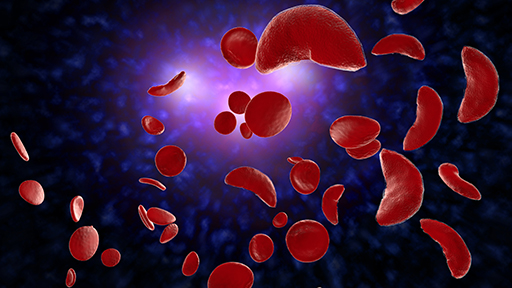Researchers at the National Human Genome Research Institute (NHGRI) are seeking help from people affected by SCD to find the factors - environmental, social and genetic - that impact the severity of symptoms. They hope to develop guidelines and educational programs aimed at reducing the severity of SCD symptoms.
"Scientists identified sickle cell anemia in 1910, but there is still much to learn about the disease," said Vence L. Bonham, Jr., J.D., an associate investigator with NHGRI's Social and Behavioral Research Branch, Division of Intramural Research. "We aim to improve our understanding of the disease."

SCD occurs in people who inherit two copies of the sickle cell gene, one from each parent. This produces abnormal hemoglobin, called hemoglobin S. [Hemoglobin is the protein molecule in red blood cells that carries oxygen from the lungs to the body's tissues and returns carbon dioxide from the tissues to the lungs.] When an individual inherits one copy of the sickle cell gene from a parent, the person is said to have sickle cell trait (SCT). People with SCT usually do not have any of the symptoms SCD and live a normal life.
SCD affects approximately 100,000 Americans. Among African Americans, 1 in every 365 is born with sickle cell disease and about 1 in 13 are born with sickle cell trait. Although the risk is greater among African Americans, many people are affected by both SCD and sickle cell trait, including those from Latin America, Mediterranean countries, the Middle East, Asia and India.
The goal of Mr. Bonham's study, Insights Into Microbiome and Environmental Contributions to Sickle Cell Disease and Leg Ulcers Study (INSIGHTS Study), is to improve the understanding of participants' health status by studying the role of the microbiome (bacteria, fungi and viruses living in and on all humans), the genome (all the genes in a person), and the social and environmental factors that may impact their symptoms. Mr. Bonham is recruiting adults living with SCD (18 years or older), with and without leg ulcers. Participants will be seen at the NIH Clinical Center in Bethesda, Maryland.
"We have organized a multidisciplinary team of experts to explore how the disease varies from person to person," said Mr. Bonham. "They will seek to understand things like the role of stress, the impact of the microbiome and social factors on health status and quality of life."
In addition, Dr. Koehly's research aims to understand how families are affected by SCD and the different factors that help or hurt their discussions and understanding about the disease and trait. This information will help Mr. Bonham's team understand whether the role of the family is important to the onset of symptoms and complications associated with SCD.
Dr. Koehly's team is also reviewing available sickle cell resources and will be asking study participants to evaluate these resources and provide feedback on what is missing. Based on that feedback, Dr. Koehly's team plans to develop resources to help families improve their understanding of SCD, sickle cell trait, and how best to cope with the disease and trait. Dr. Koehly is recruiting adults 18 years or older affected by SCD or SCT, or adults who are related to or married to someone who has SCD or SCT.
"We want to have as many voices as we can from families with sickle cell disease and trait to understand how they are managing. This will help future generations who are at risk," said Dr. Koehly. "We want to build the foundation for understanding how families communicate with and provide support to members who are affected by sickle cell. We can only achieve this by really listening to the individuals and their family members affected by this condition."



